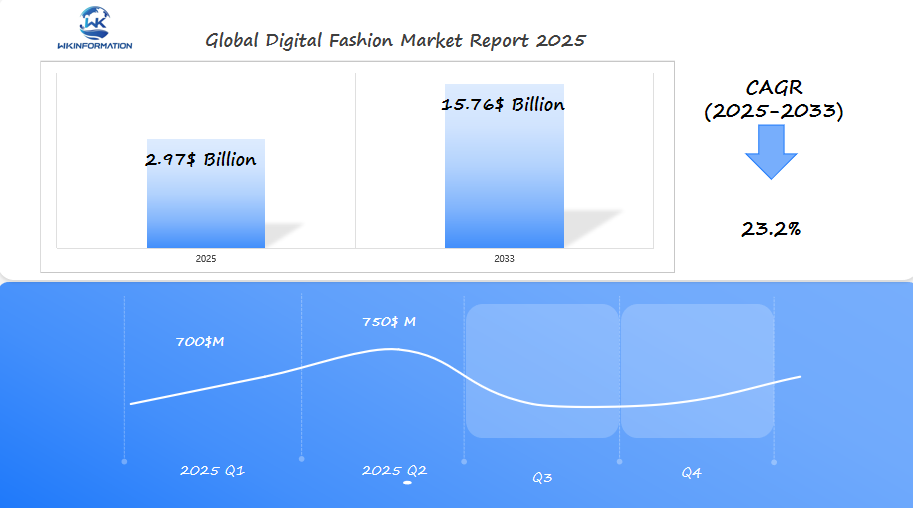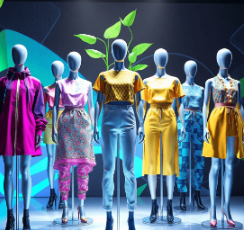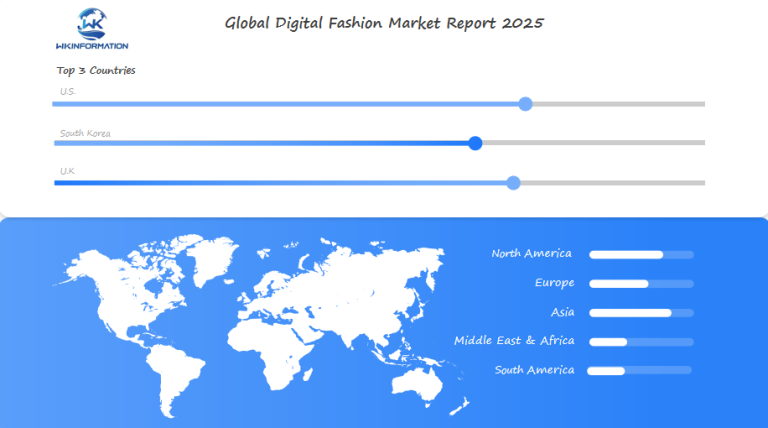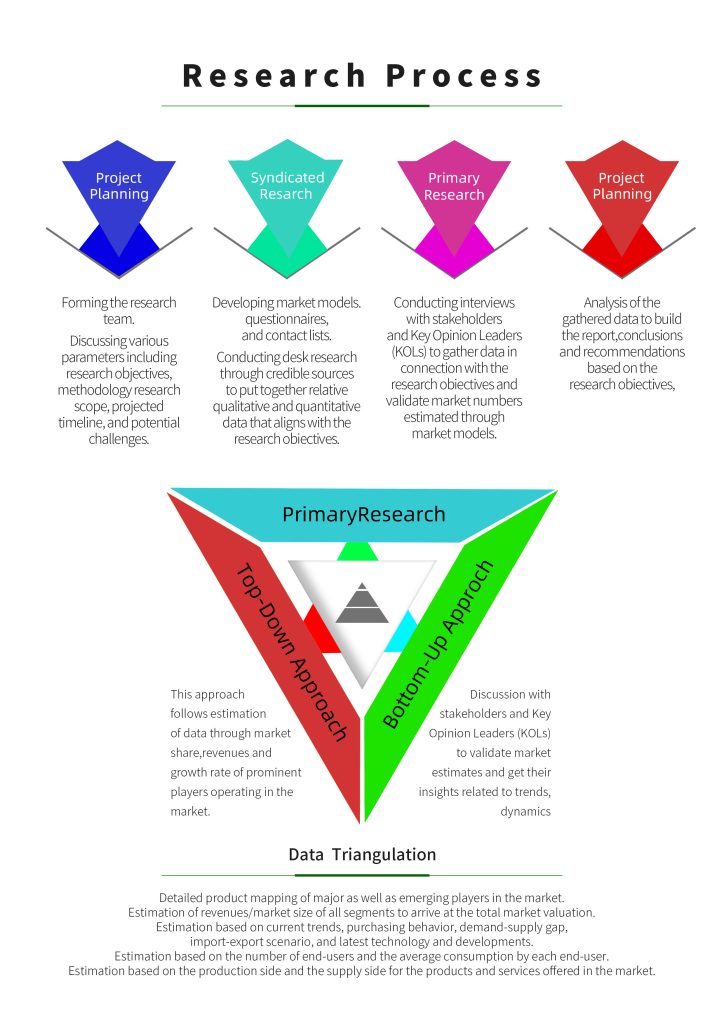$2.97 Billion Rising Demand for Digital Fashion Market in the U.S., South Korea, and U.K. by 2025
Discover the future of digital fashion in our comprehensive market analysis for 2025-2033. From cutting-edge technologies and sustainable practices to market segmentation and regional insights, explore how digital innovations are revolutionizing the fashion industry. Learn about key growth drivers, emerging trends, and the transformative impact of e-commerce on consumer engagement in this dynamic sector.
- Last Updated:
Digital Fashion Market Q1 and Q2 2025 Forecast
The Digital Fashion market is expected to reach $2.97 billion in 2025, with a CAGR of 23.2% from 2025 to 2033. In Q1 2025, the market is projected to generate approximately $700 million, driven by the rising popularity of digital clothing, virtual fashion shows, and the integration of AR and VR technologies in the U.S., South Korea, and the U.K. The growing demand for virtual clothing and the increasing adoption of digital assets for avatars and gaming platforms are key factors propelling market expansion.
By Q2 2025, the market is forecasted to reach $750 million, fueled by collaborations between fashion brands and technology companies for digital clothing lines, as well as the rise of NFTs and metaverse fashion. The U.S. is expected to lead the market, with South Korea and the U.K. following closely behind.

Exploring the Supply Chain of Digital Fashion and Virtual Clothing
Digital fashion supply chains represent a revolutionary shift from traditional garment manufacturing. These digital ecosystems operate through sophisticated software platforms, 3D modeling tools, and cloud-based collaboration systems.
Key Components of Digital Fashion Supply Chains
The core components of digital fashion supply chains include:
- Design and Development: 3D modeling software creates virtual garments
- Digital Asset Management: Cloud storage systems maintain design files
- Distribution Platforms: Digital marketplaces deliver virtual clothing to consumers
- Virtual Fitting Solutions: AI-powered systems ensure proper digital fit
Role of AI in Transforming Supply Chain Operations
AI technology transforms these supply chain operations through:
- Predictive analytics for trend forecasting
- Automated quality control of digital assets
- Real-time inventory management of virtual items
- Personalized customer experience optimization
Challenges in Managing Virtual Clothing Supply Chains
The management of virtual clothing supply chains presents unique challenges:
- Technical Infrastructure: Maintaining robust platforms for seamless delivery
- Data Security: Protecting digital assets from unauthorized replication
- File Compatibility: Ensuring cross-platform functionality
- Quality Standards: Establishing metrics for digital product excellence
Opportunities for Innovation in the Face of Challenges
These challenges create opportunities for innovation:
- Development of standardized file formats
- Implementation of blockchain technology for authentication
- Creation of virtual fitting rooms using augmented reality
- Integration of sustainable practices in digital design
The digital fashion supply chain continues to evolve as technology advances, creating new possibilities for virtual clothing distribution and consumption.
Key Trends Shaping the Digital Fashion Industry
The digital fashion landscape has transformed dramatically with e-commerce emerging as a primary growth driver. Online fashion retail sales have surged by 85% since 2020, revolutionizing how consumers interact with fashion brands and make purchasing decisions.
Virtual Experiences Redefining Fashion Engagement
Virtual experiences have captured consumer imagination, creating new ways to engage with fashion:
- Digital showrooms allowing 360-degree product views
- Virtual fitting rooms with body scanning technology
- Interactive social shopping experiences
- Real-time style recommendations
AI-Powered Personalization Enhancing Customer Connections
AI-driven personalization has redefined customer relationships in digital fashion. Brands now leverage sophisticated algorithms to:
- Create custom-fit garments based on individual measurements
- Suggest personalized style combinations
- Predict future purchase preferences
- Adjust pricing based on consumer behavior
This trend is part of a larger movement where Artificial Intelligence is transforming the future of retail, making shopping experiences more efficient and tailored to individual needs.
Innovative Retail Solutions Improving Shopping Experiences
The integration of smart mirrors in retail spaces enables shoppers to virtually try different styles, colors, and accessories without physical changing rooms. These innovations have led to a 40% increase in customer satisfaction and a 25% reduction in return rates.
Social Media Platforms Transforming Fashion Commerce
Social media platforms have evolved into virtual fashion marketplaces, with features like Instagram Shopping and TikTok’s shoppable videos driving spontaneous purchases. This shift has resulted in a 150% increase in social commerce transactions within the fashion sector.
Challenges in the Digital Fashion Market: Sustainability and Accessibility
The digital fashion market faces unique sustainability challenges despite its virtual nature. Digital assets require significant computing power and energy consumption, particularly in blockchain-based NFT fashion items. These digital processes generate substantial carbon footprints through server maintenance and continuous online operations.
Key Sustainability Issues:
- High energy consumption from cloud storage systems
- Environmental impact of digital rendering processes
- Resource-intensive blockchain transactions for digital fashion NFTs
- Electronic waste from devices needed to access virtual fashion
Accessibility Barriers:
- Limited device compatibility across platforms
- High-cost entry points for premium digital fashion items
- Technical knowledge requirements for virtual clothing platforms
- Internet connectivity disparities affecting user experience
The digital fashion industry must address socioeconomic gaps in access to technology. Many virtual fashion platforms require high-end devices or stable internet connections, creating barriers for potential consumers in developing regions.
Current Industry Solutions:
- Implementation of energy-efficient rendering technologies
- Development of cross-platform compatibility
- Creation of affordable digital fashion lines
- Integration of user-friendly interfaces for diverse age groups
Digital fashion brands are exploring innovative ways to reduce their environmental impact while making their products more accessible. Companies are investing in green server solutions and developing simplified user interfaces to accommodate varying levels of tech literacy.

Geopolitical Factors Impacting Digital Fashion Adoption
Geopolitical factors such as trade policies, technological infrastructure, and cultural preferences play a significant role in shaping the digital fashion industry. For instance, the ongoing trade tensions between the U.S. and China have prompted fashion brands to explore alternative digital supply chains, opening up new opportunities in emerging markets like Vietnam and Indonesia.
Regional Market Characteristics:
1. North America
- High digital infrastructure maturity
- Strong e-commerce penetration
- Consumer preference for established brands
- Adoption rate: 35% of fashion consumers
2. Asia-Pacific
- Rapid technological advancement
- Mobile-first shopping behavior
- Early adoption of digital innovations
- Adoption rate: 45% of fashion consumers
Data privacy regulations also create distinct market environments. The EU’s General Data Protection Regulation (GDPR) affects how digital fashion platforms operate in the UK, while South Korea’s Personal Information Protection Act influences regional market dynamics.
Cross-Border Challenges:
- Currency fluctuations affecting the value of digital assets
- Varying cryptocurrency regulations impacting NFT fashion
- Different data localization requirements
- Regional standards for intellectual property protection
The Asia-Pacific region is experiencing faster adoption of digital fashion due to several factors:
- Advanced 5G infrastructure
- Higher integration of social media platforms
- Strong government support for digital initiatives
- A young population that is tech-savvy
These differences between regions create unique opportunities and challenges for digital fashion brands looking to expand globally.
Types of Digital Fashion: Virtual Clothing, NFTs, and More
Digital fashion includes various virtual products that resemble real-world fashion items. Here’s a breakdown of the main categories:
1. Virtual Apparel
- Digital replicas of physical clothing
- AR-enabled virtual try-on garments
- 3D-designed original pieces
- Social media filters and digital overlays
2. Digital Accessories
- Virtual jewelry and watches
- Digital handbags and footwear
- AR glasses and headwear
- Custom avatar accessories
3. NFT Fashion Items
NFTs have transformed digital fashion ownership through:
- Limited edition virtual collections
- Blockchain-verified authenticity
- Cross-platform wearables
- Digital fashion collectibles
The integration of NFTs in fashion creates unique experiences through:
- Exclusive access to virtual fashion shows
- Digital clothing ownership rights
- Trading opportunities in virtual marketplaces
- Customizable digital assets
Digital fashion items serve multiple purposes across platforms:
- Social media content creation
- Virtual world avatars
- Gaming character customization
- Digital art collections
These virtual fashion categories continue to grow as technology advances, opening up new ways for self-expression in digital spaces. Brands and independent designers use these formats to connect with tech-savvy consumers who appreciate digital ownership and one-of-a-kind virtual experiences.
Applications of Digital Fashion in Virtual Reality, Gaming, and Retail
Virtual reality and gaming platforms have become dynamic showcases for digital fashion, transforming how users express themselves in digital spaces. Leading gaming platforms like Roblox and Fortnite generate millions in revenue through virtual clothing sales, with players spending real money to customize their avatars.
VR Fashion Applications:
- Virtual showrooms allowing users to browse collections in immersive 3D environments
- Digital fitting rooms with realistic fabric physics and movement
- Social VR spaces featuring exclusive digital fashion items
- Virtual fashion shows where attendees wear digital couture
Gaming Integration:
- Character customization through purchasable digital fashion items
- Limited-edition virtual clothing collaborations with real fashion brands
- In-game fashion stores with virtual currencies
- Cross-platform digital wardrobe compatibility
The retail sector has embraced digital fashion through innovative customer engagement strategies. Major retailers now offer AI-powered virtual try-on solutions, letting shoppers visualize clothing items on their bodies through smartphone cameras or smart mirrors. These technologies reduce return rates by 36% while increasing purchase confidence.
Digital fashion marketplaces connect directly with social media platforms, enabling seamless shopping experiences through augmented reality filters and virtual clothing previews. Brands like Gucci and Nike have launched dedicated virtual stores, combining gaming elements with traditional e-commerce to create interactive shopping experiences.
Global Digital Fashion Market Insights: Growth and Forecasts
The digital fashion market is experiencing significant growth, with projections indicating a $2.97 billion market value by 2025. This expansion represents a substantial Compound Annual Growth Rate (CAGR) of 40%, driven by rapid technological advancements and changing consumer preferences.
Key Growth Indicators
Several factors are contributing to the growth of the digital fashion market:
- Increasing adoption of digital fashion platforms in Asia-Pacific countries
- Higher investments in AI-powered fashion technologies
- Rise in digital clothing purchases for social media content creation
- Growing integration of virtual fashion in traditional retail
Regional Growth Patterns
Market analysis shows specific growth trends in different regions:
- North America: 35% market share, driven by technological innovation
- Asia-Pacific: Fastest growing region with a 45% CAGR
- Europe: Strong growth in digital fashion startups
Segmented Growth Potential
The digital fashion ecosystem consists of various segments, each with significant growth potential:
- Virtual clothing: 42% CAGR
- Digital accessories: 38% CAGR
- AR/VR fashion experiences: 44% CAGR
These growth metrics indicate a major shift in consumer behavior and retail dynamics, challenging traditional norms of the fashion industry.

U.S. Digital Fashion Market: Technological Innovations and Consumer Trends
The U.S. digital fashion market is leading the way in technological advancement, with AI-powered solutions transforming consumer experiences. American retailers have adopted augmented reality (AR) fitting rooms, enabling customers to virtually try on clothes using smartphone apps and smart mirrors.
Key technological innovations driving the U.S. market:
- 3D Body Scanning: Retailers like Walmart and Target use advanced scanning technology for accurate size recommendations
- Voice Commerce Integration: Smart speaker integration allows for hands-free shopping experiences
- Blockchain Authentication: Digital fashion items receive unique identifiers, ensuring authenticity and ownership
Consumer trends in the U.S. market showcase distinct patterns:
- 73% of Gen Z shoppers discover fashion through social media
- Virtual influencers gain significant following and brand partnerships
- Demand for customizable digital wardrobes increases by 45% each year
The U.S. market shows a strong adoption of digital fashion among luxury brands. Companies such as Ralph Lauren and Michael Kors are creating exclusive digital collections, while startups are developing AI-powered styling assistants that learn from user preferences.
Digital fashion marketplaces in the U.S. have reported a 60% increase in virtual clothing purchases, especially among millennials and Gen Z consumers who prioritize sustainable alternatives to physical fashion. These platforms are incorporating cryptocurrency payments and offering exclusive digital-only collections, showcasing the market’s innovative approach to fashion technology.
South Korea's Digital Fashion Market: A Leading Tech Hub
South Korea is at the forefront of technological innovation in the digital fashion industry. This is largely due to the country’s strong digital infrastructure and tech-savvy population. With its advanced 5G networks, South Korea offers smooth virtual shopping experiences, making it an ideal place to test new digital fashion technologies.
Key Growth Factors:
- Strong mobile commerce adoption rates reaching 76% among consumers
- Advanced AR/VR infrastructure supporting virtual try-on solutions
- High social media penetration influencing fashion purchasing decisions
- Cultural emphasis on digital innovation and early technology adoption
Social media platforms in South Korea, such as Kakao and Naver, have a significant impact on shaping digital fashion trends. These platforms combine shopping features with social networking, creating a unique environment where people can discover and buy fashion items at the same time.
The digital fashion market in South Korea is benefiting from:
- Integration with K-pop and entertainment industry
- Sophisticated virtual fitting room technologies
- AI-powered fashion recommendation systems
- Blockchain-based authentication for luxury digital fashion items
Local tech giants like Samsung and LG are also playing a role in the growth of this market by developing innovative display technologies and smart mirrors for retail spaces. These advancements allow retailers to create immersive shopping experiences that blend both physical and digital aspects of fashion.
South Korean consumers have shown a particular interest in digital fashion avatars and virtual clothing. Major retailers have reported a 200% increase in the use of virtual try-on since 2021, indicating a growing demand for these technologies. The rapid growth of this market further establishes South Korea as a leader in digital fashion innovation, setting trends that influence global markets.
The U.K. Digital Fashion Market: Cultural Influence and Growth
The U.K.’s digital fashion scene is a mix of traditional British culture and modern innovation. Here’s how British culture influences the digital fashion world:
1. Street Style Integration
Digital fashion creators draw inspiration from London’s diverse street fashion, translating urban aesthetics into virtual designs.
2. Heritage Brand Adaptation
Historic British fashion houses embrace digital transformation, creating virtual versions of iconic pieces.
3. Festival Culture
British music festivals influence digital fashion collections, with virtual festival wear gaining popularity.
The U.K. market is growing in its own unique way:
- 45% year-over-year increase in digital fashion purchases
- Strong adoption among 18-34 age demographic
- Rising demand for sustainable virtual alternatives
British digital fashion stands out because of:
- Academic Innovation: Fashion technology programs at institutions like Central Saint Martins
- Digital Showrooms: Virtual fashion weeks hosted by British Fashion Council
- Collaborative Culture: Partnerships between tech startups and established fashion brands
Social class influences continue to shape the U.K.’s digital fashion market, with virtual luxury items serving as accessible alternatives to traditional high-end fashion. British consumers show particular interest in digital fashion items that reference cultural touchstones, from punk rock aesthetics to royal fashion influences.
The market sees significant growth in:
- Virtual try-on technology adoption
- Digital fashion NFT collections
- AR-enhanced shopping experiences
- Custom avatar clothing for gaming platforms
The Future of Digital Fashion: Sustainability, Virtual Runways, and Moreb
Digital fashion is on the verge of significant changes, with sustainability becoming a key focus in upcoming developments. Brands are incorporating eco-friendly practices through:
- Zero-waste digital design – Creating virtual clothing without physical material waste
- Carbon-neutral fashion shows – Replacing traditional runways with immersive digital experiences
- Blockchain tracking – Ensuring transparency in digital fashion creation and distribution
Transforming the Fashion Calendar
Virtual runway events are changing the conventional fashion schedule. These online showcases provide:
- Real-time viewer interaction
- Global accessibility
- Reduced environmental impact
- Enhanced creative possibilities through AR and VR
Personalized Fashion Experiences
The use of artificial intelligence will power customized fashion encounters:
- AI-powered virtual styling assistants
- Custom-fit digital garments
- Predictive trend analysis
- Smart wardrobe management systems
Reshaping Consumer Engagement
New technologies are redefining how consumers connect with fashion:
- Holographic displays for at-home fashion shows
- Mixed reality shopping experiences
- Digital-only fashion collections for social media
- Virtual influencer collaborations
These advancements indicate a move toward sustainable, inclusive, and tech-savvy fashion experiences that unite physical and digital worlds.
Competitive Landscape in the Digital Fashion Industry
- Nike Inc. – Beaverton, Oregon, USA
- Adidas AG – Herzogenaurach, Germany
- LVMH (Louis Vuitton Moët Hennessy) – Paris, France
- H&M Group – Stockholm, Sweden
- Dolce & Gabbana S.r.l. – Milan, Italy
- The Fabricant – Amsterdam, Netherlands
- DRESSX – Los Angeles, California, USA
- Auroboros – London, United Kingdom
- Replicant Inc.
- Tribute Brand – Zagreb, Croatia
Overall
| Report Metric | Details |
|---|---|
| Report Name | Global Digital Fashion Market Report |
| Base Year | 2024 |
| Segment by Type |
|
| Segment by Application |
|
| Geographies Covered | · North America (United States, Canada)
· Europe (Germany, France, UK, Italy, Russia) · Asia-Pacific (China, Japan, South Korea, Taiwan) · Southeast Asia (India) · Latin America (Mexico, Brazil) |
| Forecast units | USD million in value |
| Report coverage | Revenue and volume forecast, company share, competitive landscape, growth factors and trends |
The Digital Fashion Market is constantly changing and improving, thanks to new technologies that make creativity and efficiency better. As brands work hard to provide personalized experiences, these innovations become essential tools for creating one-of-a-kind fashion solutions. The use of advanced technology not only improves design skills but also helps tackle sustainability problems.
Technologies like augmented reality and digital textile printing are raising the bar for customization and production speed. These improvements promote eco-friendly practices by reducing waste and making the best use of resources. By adopting these trends, brands gain a competitive edge, allowing them to offer exclusive products that resonate with the values of sustainable consumption.
Looking ahead, the industry is expected to find a balance between innovation and responsibility, leading to a more sustainable and vibrant digital fashion world.
Global Digital Fashion Market Report (Can Read by Free sample) – Table of Contents
Chapter 1: Digital Fashion Market Analysis Overview
- Competitive Forces Analysis (Porter’s Five Forces)
- Strategic Growth Assessment (Ansoff Matrix)
- Industry Value Chain Insights
- Regional Trends and Key Market Drivers
- Digital FashionMarket Segmentation Overview
Chapter 2: Competitive Landscape
- Global Digital Fashion players and Regional Insights
-
- Key Players and Market Share Analysis
- Sales Trends of Leading Companies
- Year-on-Year Performance Insights
- Competitive Strategies and Market Positioning
-
- Key Differentiators and Strategic Moves
Chapter 3: Digital Fashion Market Segmentation Analysis
- Key Data and Visual Insights
-
- Trends, Growth Rates, and Drivers
- Segment Dynamics and Insights
-
- Detailed Market Analysis by Segment
Chapter 4: Regional Market Performance
- Consumer Trends by Region
-
- Historical Data and Growth Forecasts
- Regional Growth Factors
-
- Economic, Demographic, and Technological Impacts
- Challenges and Opportunities in Key Regions
- Regional Trends and Market Shifts
- Key Cities and High-Demand Areas
Chapter 5: Digital Fashion Emerging and Untapped Markets
- Growth Potential in Secondary Regions
-
- Trends, Challenges, and Opportunities
Chapter 6: Product and Application Segmentation
- Product Types and Innovation Trends
- Application-Based Market Insights
Chapter 7: Digital Fashion Consumer Insights
- Demographics and Buying Behaviors
-
- Target Audience Profiles
Chapter 8: Key Findings and Recommendations
- Summary ofDigital Fashion Market Insights
- Actionable Recommendations for Stakeholders

Access the study in MULTIPLEFORMATS
Didn’t find what you’re looking for?
TALK TO OUR ANALYST TEAM
Need something within your budget?
NO WORRIES! WE GOT YOU COVERED!
Call us on: +1-866-739-3133
Email: infor@wkinformation.com
What are the key dynamics of the digital fashion supply chain?
The digital fashion supply chain involves various components, including AI integration to streamline operations, and addressing challenges and opportunities in managing virtual clothing. Understanding these dynamics is crucial for optimizing efficiency and meeting consumer demands.
How is e-commerce driving growth in the digital fashion industry?
E-commerce has become a significant driver for digital fashion, as it allows brands to reach a wider audience. Additionally, consumer interest in virtual experiences and personalization through AI further enhances the appeal of digital fashion offerings.
What sustainability challenges does the digital fashion market face?
The digital fashion market encounters several sustainability challenges, such as energy consumption in data centers and the environmental impact of producing virtual clothing. Addressing these concerns is essential for creating a more sustainable future in this industry.
How do geopolitical factors influence digital fashion adoption?
Geopolitical conditions can significantly affect digital fashion markets globally, with varying adoption rates observed between regions such as North America and Asia-Pacific. These influences shape market strategies and consumer engagement approaches.
What types of digital fashion exist beyond virtual clothing?
Digital fashion encompasses various categories, including virtual clothing, accessories, and NFTs (Non-Fungible Tokens). NFTs play a crucial role in creating unique fashion experiences by allowing consumers to own exclusive digital items.
What are the future trends expected in the digital fashion industry?
The future of digital fashion is poised for innovation, with trends focusing on sustainability practices, the emergence of virtual runway events, and enhanced consumer engagement through technology. These developments will shape the industry’s trajectory towards 2025.

